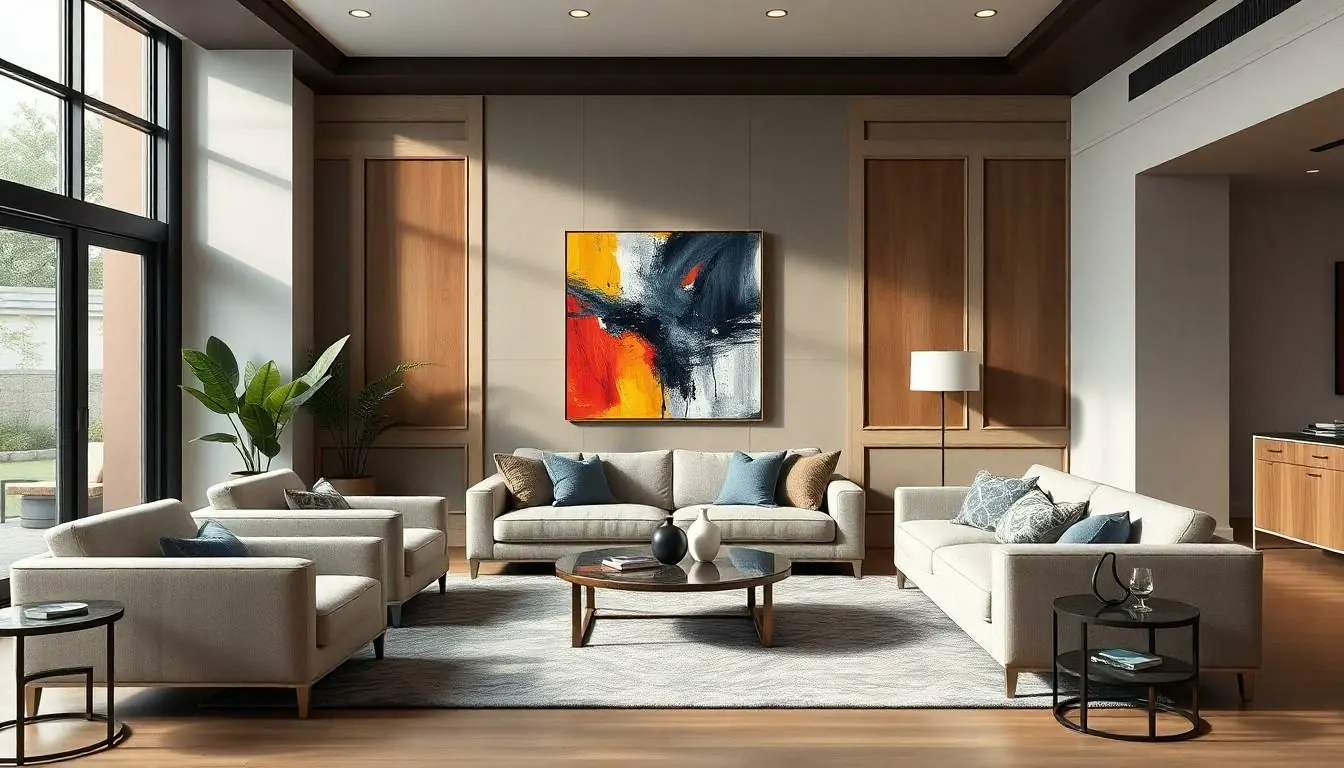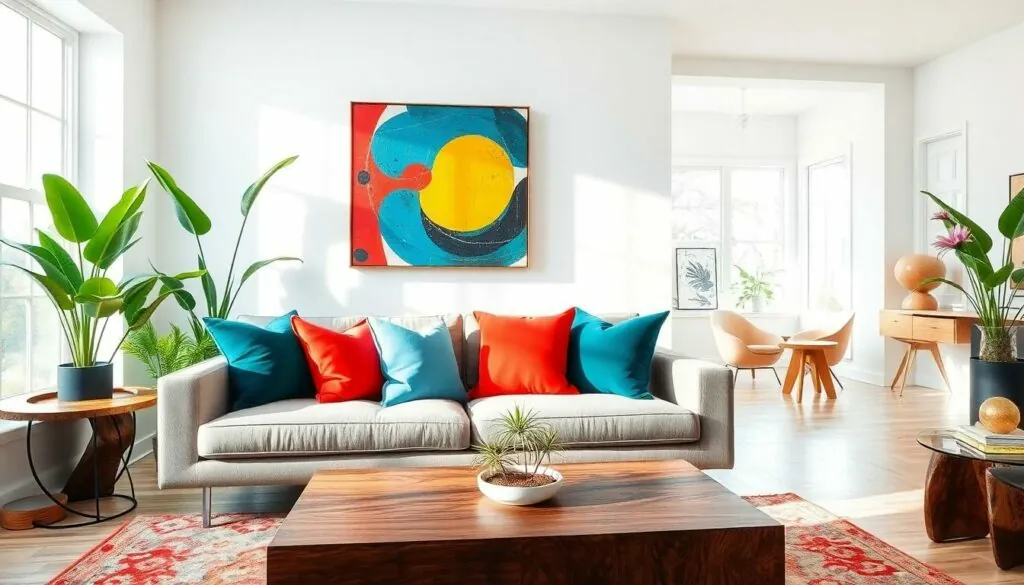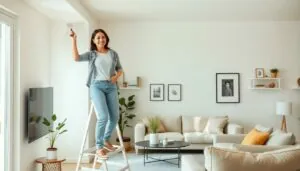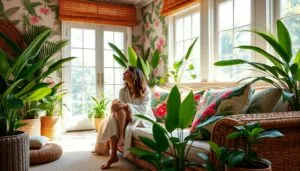In the world of interior design, where trends come and go faster than a cat meme on the internet, emphasis interior design stands out like a peacock at a pigeon convention. It’s all about creating focal points that draw the eye and make a statement, turning ordinary spaces into extraordinary experiences. Whether it’s a bold piece of art or an eye-catching piece of furniture, emphasis design transforms your home from “meh” to “wow” in no time.
Imagine walking into a room that tells a story, where every element works together to create a harmonious vibe. Emphasis interior design isn’t just about aesthetics; it’s about crafting an environment that reflects personality and style. So, if you’re ready to ditch the drab and embrace the fab, it’s time to explore how emphasis can elevate your space to new heights.
Table of Contents
ToggleOverview of Emphasis Interior Design
Emphasis interior design focuses on creating eye-catching focal points within a space. This approach enhances visual appeal by utilizing bold art pieces or striking furniture selections. Homeowners can transform ordinary rooms into vibrant living areas through careful curation of design elements.
Utilizing emphasis goes beyond mere aesthetics. This design philosophy also fosters a harmonious environment that reflects the personality and style of those who inhabit the space. An effective emphasis design promotes a sense of balance while highlighting key features. For example, strategically placing a colorful painting on a neutral wall can draw attention and create a dynamic atmosphere.
Various elements contribute to effective emphasis design. Color, texture, and shape play crucial roles in creating focal points. Incorporating contrasting colors adds depth, while differing textures can create visual intrigue. Shapes should complement one another to maintain harmony within a room.
Functional design also benefits from emphasis principles. A well-placed statement piece can enhance usability while serving as a decorative element. For instance, a uniquely designed chair can provide seating and act as a conversation starter.
Emphasizing specific areas in a home encourages exploration and engagement. Design choices that prioritize focal points invite guests to experience the unique character of the space. Ultimately, emphasis interior design offers homeowners the ability to express their individuality through impactful design choices, leaving a lasting impression on those who enter their homes.
Key Principles of Emphasis Interior Design

Emphasis in interior design relies on several foundational principles. Understanding these can significantly enhance any living space.
Balance and Harmony
Balance creates visual stability in a room. Symmetrical arrangements tend to evoke a sense of order. Asymmetrical designs can add dynamism. Harmony ties elements together cohesively, ensuring that colors and textures complement rather than clash. Using contrasting colors can energize a space, while similar shades bring a calmer feel. Each element’s scale and proportion influences balance, making it crucial for design longevity. Selecting furniture and decor with similar themes promotes integration, transforming disparate pieces into a cohesive whole.
Focal Points
Focal points anchor the eye within a space. Bold art pieces or unique furniture often serve as eye-catchers. Positioning these elements strategically facilitates engagement and exploration. Various elements like lighting can enhance a focal point, drawing attention and creating intrigue. Including contrasting colors and shapes emphasizes specific features, enhancing their impact. Element placement affects the overall spatial flow, guiding movement through the room. Integrating multiple focal points is effective when they share a common design language, maintaining a harmonious atmosphere while inviting interest.
Color Schemes in Emphasis Interior Design
Color schemes play a vital role in emphasis interior design. They set the mood and define the character of any space, making them essential for creating engaging focal points.
Warm vs. Cool Tones
Warm tones, such as reds, oranges, and yellows, evoke energy and excitement. These colors often draw attention, making them suitable for focal points like art pieces or furniture. Cool tones, like blues, greens, and purples, promote calm and tranquility. They work well as backgrounds, allowing warm accents to pop. Understanding the psychological effects of color can guide homeowners in choosing the right palette. Using a blend of both warm and cool tones adds depth and interest to a room, ensuring that the atmosphere remains dynamic yet cohesive.
Contrasting Colors
Contrasting colors create visual intrigue and excitement within a space. Combinations like blue and orange or yellow and purple energize the environment, drawing the eye toward specific elements. This technique emphasizes focal points effectively while maintaining balance in design. High-contrast schemes can highlight architectural features or unique decor items, enhancing their presence. When selecting contrasting colors, it’s crucial to consider the overall harmony with the surrounding elements. A careful approach ensures that bold choices complement rather than clash, fostering an inviting atmosphere that resonates with individual style.
Materials and Textures Used
Materials and textures play a crucial role in emphasis interior design, significantly influencing the space’s overall aesthetic and mood.
Natural vs. Synthetic Materials
Natural materials, such as wood, stone, and cotton, provide an organic feel. They create warmth and authenticity that resonates with many homeowners. Synthetic options, like leather, plastic, and engineered wood, often offer durability and a modern touch. Both categories possess unique qualities that can enhance focal points in design. Mixing these materials can also introduce contrast, making the design more dynamic. For example, combining sleek synthetic furniture with rustic wooden accents can create visual interest.
Textural Variety
Textural variety enhances the overall appeal of a space, inviting touch and engagement. Incorporating different textures, such as soft fabrics, glossy finishes, and rough surfaces, adds depth to an interior. Layering textures helps to break the monotony, creating a multidimensional experience. Velvet cushions, for instance, provide comfort, while metal accents can introduce a sleek contrast. Textural differences draw attention and stimulate curiosity, highlighting the chosen focal points. Designers strategically mix textures to ensure cohesion and emphasize personality within the space.
Emotional Impact of Emphasis Interior Design
Emphasis interior design evokes strong emotional responses by transforming living spaces into personalized experiences. Focal points such as bold artwork or unique furniture pieces capture attention and ignite conversation, making rooms feel alive. Different colors elicit specific feelings; for example, warm tones stimulate energy while cool tones promote calmness. Well-chosen colors can create an atmosphere conducive to relaxation or socialization, enhancing the mood of the space.
Textures also play a significant role in emotional resonance. Natural materials, like wood and stone, evoke feelings of warmth and comfort, contrasting sharply with sleek, modern finishes that suggest sophistication. Mixing these elements introduces a dynamic sensory experience, making environments feel more inviting. Layering various textures adds depth, encouraging interaction and engagement from occupants.
Lighting complements emphasis interior design’s emotional impact by enhancing focal points effectively. Strategic lighting can highlight key design elements, creating a dramatic ambiance that influences behavior and mood. Well-lit artwork or statement furniture draws the eye and invites exploration within the room.
Moreover, the interplay of design elements cultivates a sense of harmony. Balanced arrangements can evoke feelings of tranquility while asymmetrical designs introduce energy and movement. Each approach shapes the overall emotional landscape, reflecting the homeowner’s personality and style.
Emphasis inside the design fosters an environment rich with emotional nuance. As individuals explore their distinct tastes through impactful design choices, they invite guests to experience a space that resonates deeply. By prioritizing focal points, homeowners effectively express their uniqueness while engaging others emotionally in their living spaces.
Emphasis in interior design is more than just aesthetics; it’s about crafting spaces that resonate with individuality and emotion. By strategically incorporating focal points through color, texture, and materials, homeowners can create environments that invite exploration and engagement. The right balance of elements not only enhances visual appeal but also fosters a harmonious atmosphere.
Ultimately, embracing the principles of emphasis allows for a transformative experience that reflects personal style while evoking strong emotional responses. With thoughtful design choices, every room can become a captivating expression of who they are, leaving a lasting impression on all who enter.




